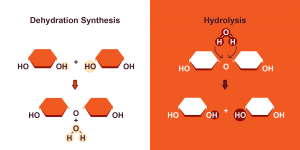Chapter 5: Biological molecules
We have discussed the structure of atoms and molecules, as well as how atoms and molecules can be rearranged by chemical reactions. Many of the molecules and compounds we have been discussing are inorganic compounds, such as sodium chloride (NaCl) or molecular oxygen (O2). These compounds do not contain the element carbon. Cells import and generate organic compounds: molecules containing carbon and synthesized by cells.
The structure of organic compounds is based on a chain of carbon atoms linked by covalent bonds known as a carbon skeleton. In the same way our bodies are framed by a skeleton, organic molecules are formed by a basic frame made of carbon chains. Recall that the valence number of carbon is four, meaning that carbon can form a maximum four covalent bonds with other atoms. Molecules that contain only carbon and hydrogen atoms are known as hydrocarbons. However, most organic compounds contain some combination of carbon, hydrogen, oxygen, and nitrogen. As a result, these atoms are the most abundant elements in cells. Other elements are less abundant in organic compounds (e.g. phosphorus and sulfur). Organic compounds synthesized and consumed by cells may also be referred to as biological molecules.
Cells contain trillions of biological molecules. However, all biological molecules are composed of relatively few subunits. Think of biological molecules like brick houses: the bricks are the building blocks or monomers from which all biological molecules are built. The many different types of brick houses are the polymers that differ by the arrangement of the bricks or monomers.
Biological monomers are incorporated one-at-a-time into larger molecules through a chemical process known as dehydration synthesis. Dehydration synthesis is the formation of covalent bonds between a growing biological polymer and an incoming biological monomer. A by-product of dehydration synthesis is a water molecule, hence the name “dehydration synthesis”. Cellular enzymes perform dehydration synthesis to build cellular molecules. Cellular chemical reactions that build more complex molecules from smaller subunits are called anabolic reactions.
The reverse reaction is called hydrolysis and involves breakage of covalent bonds between monomers in a biological polymer. Reactions that break complex molecules into simpler subunits are called catabolic reactions. Cells perform hydrolysis reactions to release biological monomers for a variety of reasons. For example, during digestion of food, cells will catabolize large food particles into smaller nutrients that can be used to generate cellular energy or build new biological molecules that the cell needs to move, grow, and divide.

There are four classes of biological molecules:
- Carbohydrates
- Proteins
- Nucleic acids
- Lipids
In this last chapter, we will examine the structure and function of each class of biological molecule.
“hydro” or water; “lysis” or splitting

